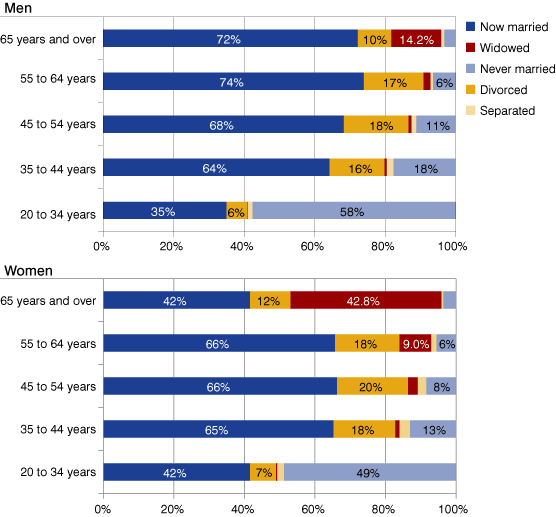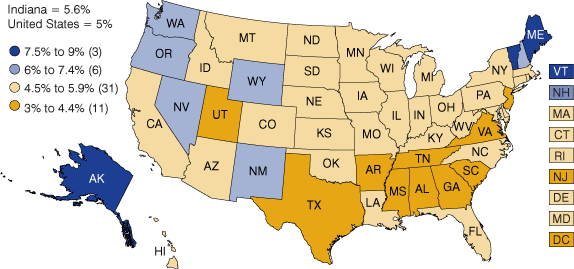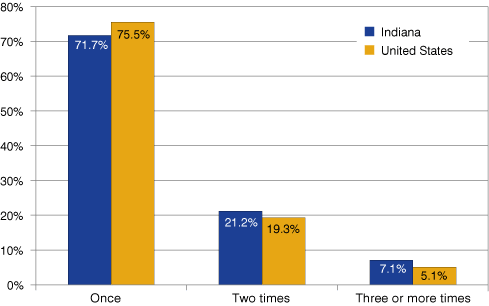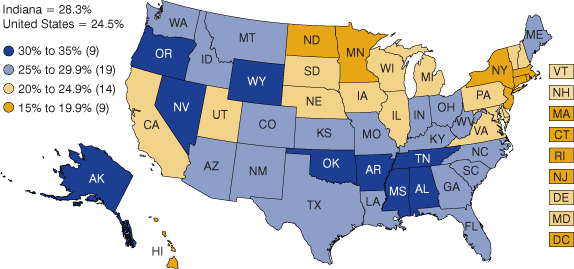The State of Hoosier Unions: A Demographic View of Marriage
Marriage is an important social milestone in many people’s lives and also affects the economy in a variety of ways. There is the merging of two households into one, the combining of incomes, and often changes to the way money is spent and saved.1 There are labor market implications associated with raising a family, not to mention that data on marital status is often used in the planning and implementation of government programs, such as low-income tax credits.2 The 2008 American Community Survey recently released by the U.S. Census Bureau gives us a glimpse into the marital state of Hoosiers.
Marriage Status
Fifty-two percent (or 2.6 million) of Indiana’s population age 15 or older is currently married.3 However, more than 3.6 million people in Indiana have been married at one time or another, accounting for 72 percent of the population age 15 or older (this is 3 percentage points higher than the nation).
Figure 1 shows the current marital status of Hoosiers by age and gender. We find a larger percentage of married women under the age of 35 compared to men in the same age group. This may seem odd, but consider the likelihood of people living in different locations while married, perhaps because of a spouse’s work or military duty, as well as the fact that women tend to marry younger than men. We also find dramatically larger numbers of widows in the two oldest age groups, accounting for 43 percent of all women age 65 and over.
Figure 1: Marital Status in Indiana, 2008

Source: IBRC, using data from U.S. Census Bureau
Note: For both genders, 99 percent of the 15-to-19 age group fall into the "never married" category.
Work seems relevant to marriage as well. Fifty-nine percent of men in the labor force (working or looking for work) are married. However, a smaller proportion (53 percent) of women in the labor force are married.
We also find that a larger proportion of the foreign born are married (59 percent) compared to native born (51 percent). There are distinctive differences among the population based on race and ethnicity, as well (see Table 1). The highest proportion of marriage occurs among the Asian population, at 60 percent, with a low of 28 percent among blacks. Among whites, 54 percent of those 15 and older are married.
Table 1: Percent of People Currently Married in Indiana, 2008
| Total Population Age 15 and Older | 52% |
| Men | 54% |
| Women | 50% |
| Native Born | 51% |
| Foreign Born | 59% |
| White | 54% |
| Black | 28% |
| Asian | 60% |
| Hispanic (can be of any race) | 48% |
Conversely, 31 percent of men and 25 percent of women in Indiana have never been married. Nationwide, there are higher percentages of those never married for both men (35 percent) and women (28 percent). As shown in Figure 1, the percentage of those never married decreases as the age group gets older.
While these differences between young and old might be explained by the ongoing search for “the one” among the youngest age groups, it may also indicate the generational shift in attitudes toward cohabitation. Cohabitation is often a temporary arrangement that precedes marriage, but some may be foregoing marriage entirely. Households consisting of unmarried opposite sex partners account for 5.6 percent of all households, ranking Indiana 16th among the states. The U.S. figure is lower at 5 percent, with the states ranging from 3.1 percent in Alabama to 8.8 percent in Alaska (see Figure 2).
Figure 2: Percent of Households with Unmarried Opposite Sex Partners, 2008

Source: IBRC, using data from the U.S. Census Bureau
Median Age at First Marriage
While the median age at first marriage has been increasing, Hoosiers still tend to marry younger than Americans overall. In Indiana, the median age at first marriage for men is 26.9, ranking 36th among the states; the U.S. average is 28 years. Women in Indiana tend to marry slightly younger than Hoosier men, at the median age of 25.8 (ranking 29th among the states). This is quite close to the U.S. average of 26.2, though the difference is still statistically significant.4
Duration
For those currently married, the median duration of the marriage is 18.8 years in Indiana, meaning that half of current marriages have lasted longer and half have been shorter. This is a few months longer than the U.S. figure.5
Divorce
Overall, 12.3 percent of Hoosiers age 15 and older are currently divorced. A slightly larger proportion of women in Indiana are divorced compared to men (13.1 percent and 11.5 percent, respectively). Among racial groups, Asians in Indiana have the lowest proportion (4.9 percent) while American Indians have the highest (24.5 percent). Meanwhile, 7.1 percent of the Hispanic population (which can be of any race) is currently divorced.
Remarriage
For the first time, the Census Bureau collected data on the number of times people have been married (see Figure 3).
Figure 3: Percent of People Ever Married by Number of Times Married, 2008

Source: IBRC, using data from the U.S. Census Bureau
Nationwide, 24.5 percent of those people who have ever married have been married more than once. Indiana ranks 14th among the states on this measure, at 28.3 percent. Arkansas ranks highest, with 34.8 percent (of all those who have ever married) tying the knot more than once (and almost 10 percent marrying three or more times), while Massachusetts ranks lowest at 16.2 percent (see Figure 4).Figure 4: Percent of People Ever Married That Have Been Married More Than Once, 2008

Source: IBRC, using data from the U.S. Census Bureau
Conclusion
Hoosiers apparently enjoy being part of a couple based on these 2008 figures. Not only are people in Indiana more likely to marry than the average American, a larger percentage of Indiana households consist of cohabitating unmarried partners. Hoosiers also tend to marry younger and have higher rates of remarriage than the national average. Marriage status varies, however, when looking at different race and ethnic groups. The social and economic implications of all this can be significant and are certainly worthy of more in-depth research than our overview here can cover. For more detailed information, we recommend using the Census Bureau’s American FactFinder at https://data.census.gov/cedsci/ and selecting the 2008 American Community Survey Data set, and searching for Marital Status.
Notes
- Shoshana A. Grossbard-Shechtman, ed., Marriage and the Economy: Theory and Evidence from Advanced Industrial Societies (Cambridge: Cambridge University Press, 2003).
- Rose M. Krieder and Tavia Simmons, “Marital Status: 2000,” Census 2000 Brief, October 2003.
- All statistics in this article are limited to the population that is age 15 or older except for the labor force participation statistics, which are calculated based on those age 16 or older.
- This difference is significant at the 99 percent confidence level. To learn more about statistical significance, see Rachel Justis, “The Search for Significance: A Crash Course in Statistical Significance Using ACS 2007,” InContext, November-December 2008, www.incontext.indiana.edu/2008/nov-dec/4.asp.
- The difference between Indiana and the United States is statistically significant at the 90 percent confidence level, but not at the 95 percent confidence level.
Rachel Justis
Geodemographic Analyst, Indiana Business Research Center, Indiana University's Kelley School of Business
Carol O. Rogers
Deputy Director and Chief Information Officer, Indiana Business Research Center, Indiana University's Kelley School of Business
